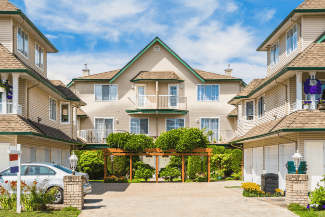Small Multifamily Homes Were Disappearing. Now States Are Scrambling to Revive Them
Construction of low-density housing like duplexes hovers near record lows, as states pass zoning reform to tackle the affordable housing crisis.
More small multifamily homes are needed to help solve America’s housing crisis, but they make up an ever-shrinking share of new housing construction.

States like Oregon, California and Maine have effectively ended single-family zoning, revising regulations to allow duplexes, triplexes and other multifamily units to be built, while lawmakers in Arizona and Rhode Island introduced similar legislation this year. President Joe Biden is also pushing for more middle housing with a plan that rewards areas that implement zoning reforms.
These efforts are trying to reverse a decades-long decline in middle housing that dates back to the post-World War II era, when many areas were rapidly zoned to permit only single-family homes, often to perpetuate racial exclusion and segregation. But proposed changes have also been met with backlash everywhere from Austin, Texas to New York City by those in the “Not in my Backyard” movement who view new developments as a threat.
“In the 1980s when a lot of these laws were passed, it wasn’t as big of a deal to say, ‘We really want to restrict a lot of stuff to single-family homes,’ because there’s a lot more empty land,” said Michael Manville, a professor of urban planning at the University of California, Los Angeles. “There was always the next valley to go to. Now, that’s much harder.”
The issue has taken on increased urgency since the 2008 recession, after which the construction of single-family homes and apartment buildings with 10 or more units rebounded even as middle housing lost further ground. The recession “decimated” the construction industry as homebuilders went out of business and has never fully recovered, said Daniel Parolek, the founding principal of architecture firm Opticos Design, who coined the term “missing middle housing.” Those that could stay open focused on what would deliver the highest profit: single-family homes.
“There’s just not enough builders. I’m not an economist, but high demand and little supply sort of skews the market pretty dramatically. And in this instance, we see that builders can build almost anything and it’ll sell and there’s still enough demand,” said Parolek. Building detached single-family homes is “a pretty safe business model, and it has delivered pretty good profits for them, so they’re just reluctant to change that.”
More than half of the 368,000 multifamily units built in the US last year were completed in buildings with 50 units or more, and nearly 88% of multiple-unit buildings constructed in 2022 contained 20 units or more, according to US Census Bureau data. In comparison, only about 2,000 duplexes were constructed.
Middle housing could fulfill much of the American aspiration of owning a single-family home at a lower price point, said Jake Wegmann, an associate professor at the University of Texas at Austin’s architecture school. There would still be outdoor space to raise pets and children, more privacy than an apartment block, and shortened commutes.
“Maybe a generation of young people had grown up in those suburbs and were hungering for something different. Maybe it was the large millennial generation who started coming of age, who are interested in living somewhere more social and happening than a suburban environment,” Wegmann said. “But whatever the case, people started to notice that that was a real opportunity.”
Need a Lease Agreement?
Access 150+ state-specific legal landlord forms, including a lease.
Multifamily units, including middle housing, are also more appealing in a high-mortgage environment, as rising rates have created the worst affordability crisis in almost four decades. Nearly all multifamily units constructed in 2022 were intended for rent, and those built for sale usually sell at lower price points than nearby single-family homes.
In areas where zoning laws have been changed to promote middle housing construction, authorizations for duplexes and other small multi-unit buildings have ticked up. Oregon’s law passed four years ago required that smaller cities allow the construction of duplexes starting in 2021 and that larger cities allow up to fourplexes and several other types of middle housing by June 2022. Housing authorizations for duplexes in the state are rising and on track to be the highest in several years, according to US Census Bureau data, which largely aligns with a more limited dataset provided by the state. Both sources estimate that, between 2018 and 2022, permits were issued for the construction of more than 850 triplex and quadruplex units in Oregon.
California’s Housing Opportunity and More Efficiency (HOME) Act, which took effect at the start of 2022, streamlines the process for building duplexes or subdividing lots for the construction of additional single or small multifamily homes. The state reports 165 units have been constructed as a result of the new legislation, and another 194 applications for lot splits have been submitted.
While these changes help smaller-scale developers who don’t have the budget to fight existing zoning laws, Andrew Malick, a developer in San Diego, said that finances are still a barrier to building middle housing.
California has found that “the industry is taking a long time to catch up to the changes in these rules,” Malick said. “The legislators are saying, ‘Hey, you told us to make it easier to build. We made it easier to build. Why aren’t you building?’ Well, the other side of that lens was the financing.”
Building larger projects ends up being easier because Malick can afford to hire people to help with steps like acquiring land and designing projects. Institutional buyers are also more interested in larger buildings, as it’s more profitable to pay three employees to run a 100-unit apartment building than a smaller building, he said. Changes to loan structures for smaller projects could allow more small-scale developers to enter the market and construct middle housing, Malick said.
Factors like these, as well as broader macroeconomic factors, may be “just as significant—if not more significant—than zoning in impacting whether cities will see a gradual increase in housing and density in former single-family-only neighborhoods,” according to a report from the Terner Center for Housing Innovation at the University of California, Berkeley.
Some California homeowners are already taking action to add another housing option to their neighborhoods with the help of the state’s HOME Act. Elaine Schaefer Hudson, a 73-year-old artist, recently received city approval to split her property lot in Citrus Heights. She is working with the company BuildCasa to handle the permitting and construction process so that another single-family home can be built on the land.
“The housing crisis is real here. We need the housing, we need single, duplex and fourplex units,” Schaefer Hudson said. “A mixed neighborhood is far more viable than cute little uniform house after house.”
In Sacramento, Jack Schwartzman and his wife are also working with BuildCasa to build a duplex on their newly subdivided land.
“There needs to be more housing and this is just another interesting way of doing it,” Schwartzman said. “I’m sure some people are fearing that it’ll change the neighborhood and they’re probably right, but I think it may be for the greater good.”
Source: Bloomberg Citylab















 Accessibility
Accessibility